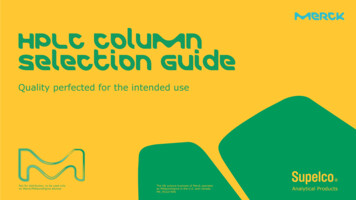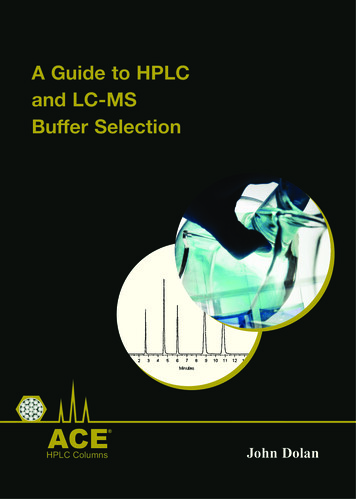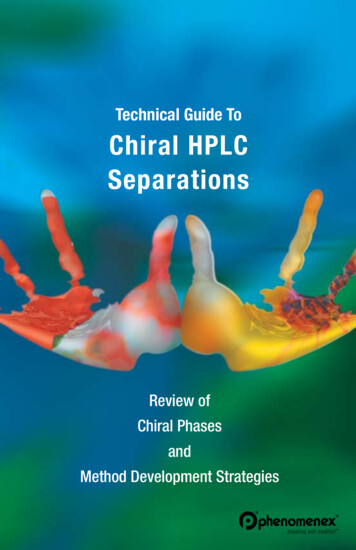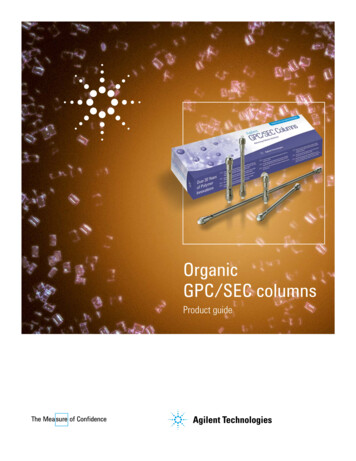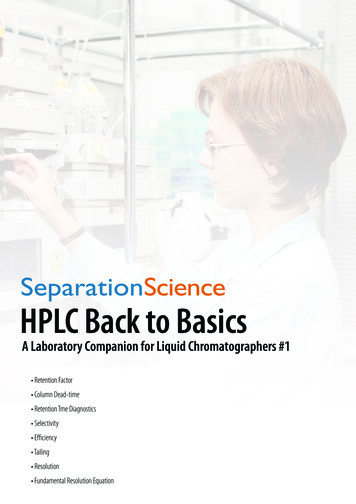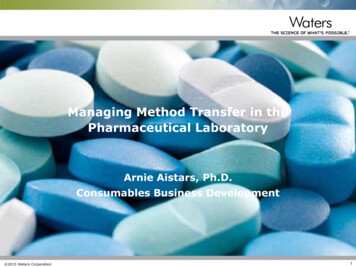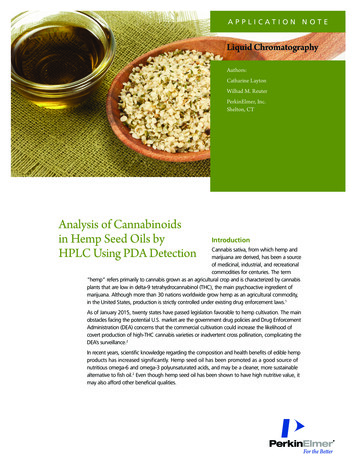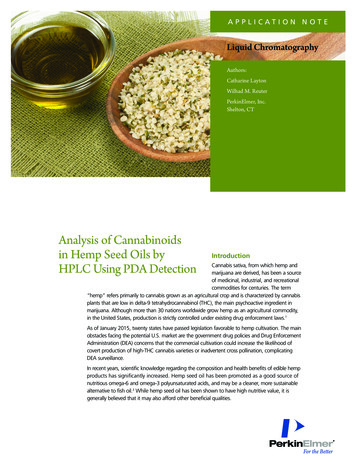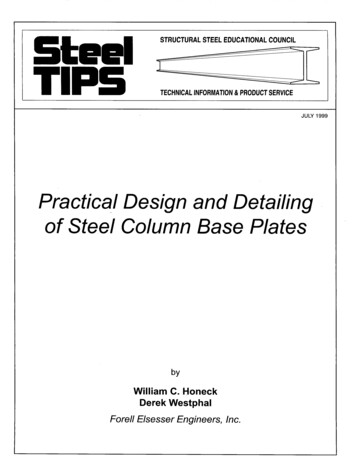
Transcription
SELECTINGHPLC COLUMNS:GOING UNDER THE HOODHPLC Column Selection Guide
INTRODUCTIONWith hundreds of stationary phases and columns commercially available in themarket, it can be difficult to select the right HPLC column for your application.We are here to help. This guide provides direction on column selection and helpsassist you through the development of your methods.At the end of this article you will find a concrete and usefulapplication of theoretical and scientific work transformed intoa practical tool enabling chromatographers to find the rightHPLC column easily and in just a few seconds.TABLE OF CONTENTSCHROMATOGRAPHY FUNDAMENTALS. 3Retention Factor.3Selectivity Factor.3Efficiency.3Resolution.4Peak Asymmetry.4COLUMNS AND MOBILE PHASES.WHERE CHEMISTRY MEETS SILICA. 4Pore Size Dimensions.4Particle Size Dimensions.4Column Dimensions.4pH and Mobile Phase: Solvent-Strength Selectivity and Solvent-Type Selectivity.5Stationary Phase Chemistries.5Reversed Phase Chemistries.5CHARACTERIZATION OF C18 PHASES-CHROMATOGRAPHIC TESTS. 6Chemometrics.7Principal Component Analysis.7PUTTING THEORY INTO PRACTICE: PERKINELMER UNIVERSAL LC COLUMN FINDER WEB TOOL.8Find The Right or Equivalent Column Quick and Easy.8PERKINELMER BROWNLEE SPP COLUMNS.82
PerkinElmer HPLC Column Selection GuideCHROMATOGRAPHY FUNDAMENTALSCHROMATOGRAPHY FUNDAMENTALSRetention FactorThe retention factor (k) described in Equation 1 and in Figure 1is a thermodynamic parameter, independent of some keyvariable factors including flow rate and column dimensions.Because of this, it is a useful parameter when comparing theretention of various solutes obtained using different HPLCsystems in isocratic mode.kA tRA -- totoEquation 1. With tR the retention time of the analyte A,Aand to the dead time.Also, the temperature has to be considered as it drastically altersthe selectivity for some pairs of analytes.Last, but not least, one of the most efficient ways to change theselectivity is to change the stationary phase to another chemistryor material “molecular” structure.EfficiencyThe efficiency of a peak is a kinetic parameter measuring thedispersion of the analyte band during the path through the HPLCsystem and column. This dispersion depends on the system analyte,mobile phase, and stationary phase for a given analysis temperature.The chromatographic parameter reflecting the column performanceis the number of plates (N ) and is described on the Equation 3:N 5.54 ( (tR2W1/2 LHEquation 3. Plate number. With W ½ the half-height peakwidth, H the height equivalent to a theoreticalplate, and L the column length.Figure 1. Retention in chromatography.Chromatographers like keeping retention factor values between2 and 10 for optimized separations. The most effective andconvenient way to alter the retention factor is to adjust thesolvent strength of the mobile phase, typically modifying theamount of organic solvent in the mobile phase mixture.Selectivity FactorThe selectivity factor (a) described in Equation 2 is anotherthermodynamic parameter, and corresponds to the ability ofthe chromatographic system to distinguish two successiveeluted components.kBaA,B kAEquation 2.The selectivity starts at one for co-eluted compounds, while highvalues indicate better separating power. This factor depends onthe system analyte, mobile phase, and stationary phase for a givenanalysis temperature; and all these parameters may be altered tooptimize or change the HPLC separation. Altering the systemselectivity is a good strategy to optimize the resolution, since smallchanges in selectivity can lead to large changes in resolution.The model proposed in “Partition Chromatography” by J.P. Martinand Richard L.M. Synge relies on the separation of the column intoplates. Each plate represents the distance over which the analyteachieves one equilibration between the stationary phase and themobile phase. Consequently, the more plates available, the moreequilibria possible, and the better the quality of the separation.Many factors contribute to the peak broadening, but considering anoptimized system with negligible extra-column volume, the biggestcontribution comes from the column itself. The quality of thecolumn packing, as well as the length of the column, but also boththe particle size dispersion and dimension, play an important role inthe overall efficiency.The diffusion of analytes through the column is represented by theVan Deemter curve. The effect of the mobile phase velocity on theheight equivalent to a theoretical plate (H) is linked to the efficiencyand the column length by the equation in Equation 4 and Figure 2:H A Bµ CxµEquation 4.For a specific application with a specific column, changes in themobile phase can be applied to change the selectivity: Water content to change the solvent strength Organic modifiers to change the type of interactions pH value, which alters the degree of ionization of someanalytes affecting their hydrophobicity Solvent additivesFigure 2. Van Deemter curve.3
PerkinElmer HPLC Column Selection GuideCOLUMNS AND MOBILE PHASES.WHERE CHEMISTRY MEETS SILICAA-factor is the convective dispersion or streamline-splitting (eddydiffusion) parameter, related to channeling through a non-idealpacking. It can be minimized by packing columns homogeneouslywith silica particles of controlled granulometry.Also, the nature and the size of the particles is very importantfor column efficiency. Smaller particles lead to higher efficiencyand does so employing superficially porous particles (SPP) insteadof totally porous particles.B-factor is the longitudinal molecular diffusion coefficient ofthe eluting analytes in the longitudinal direction. It can beminimized by working at higher flow rates, by using lowerinner-diameter tubing and connections, and using a organicmodifier of lower viscosity.C-factor is the resistance to the mass transfer of the analyte in theimmobilized mobile phase and in the stationary phase. It can beminimized by using particles of a smaller diameter, superficiallyporous instead of totally porous particles, working with a lowerflow rate, and higher temperatures.ResolutionObtaining the optimal resolution in the least amount of timeis a challenge for chromatographers. A value of 1.5 or morebetween two peaks of approximately the same magnitude ensuresa convenient baseline separation. As demonstrated by thefundamental in Equation 5, the resolution (Rs) is affected by threeimportant parameters: selectivity, efficiency, and retention.R SA,B NB x aA,B -1 x4aA,BEquation 5.kBkB 1Peak AsymmetryIdeally, all chromatographic peaks should be symmetrical(Gaussian). However, due to the effects of instrumentextra-volumes, absorptive effects of the stationary phase, andthe quality of the column packing, peaks are often distorted.Asymmetrical peaks lead to a loss of resolution, makingquantification tricky. The asymmetry factor is estimated at10% of the peak height. The tailing factor is estimated at5% of the peak height. These two parameters are calculatedaccording to Equation 5 and Figure 3.As Equation 6.4BCACand TF AB2ACFigure 3. Tailing peak and asymmetry factor.Standard limits are set for peak asymmetry. An asymmetry valuebetween 1-1.05 (1 TF 1.033) is considered excellent, and up to1.5 (corresponding to TF 1.33) is considered acceptable.COLUMNS AND MOBILE PHASES.WHERE CHEMISTRY MEETS SILICAPore Size DimensionsThe choice of pore size is of crucial interest when developing amethod for a class of compounds. Selecting a column based onsilica particles with small or standard pore sizes (around 60 to120 Å) to analyze large molecules (over 3000 g.mol-1) will resultin size exclusion. Columns packed with 300 Å pore size particlesare recommended for biomolecule analysis.Particle Size DimensionsThe typical particle size for HPLC columns is 3 μm or 5 μm,but smaller diameters have grown in popularity. If high-speed orhigher resolution analyses are required, columns containing 1.8 µmor 2-3 µm particles can be used. Shorter columns with theseparticles can produce faster separations, but longer columnsare required for higher efficiency. Longer columns packed withsmaller particles highly improve the global efficiency, but alsodramatically increase back-pressure, making this procedureonly possible with UHPLC instrumentation.Column DimensionsChoosing the dimension of a column is also essential and hasdramatically changed in the past few years. While 4.6 mm idwas largely used in method development, smaller 3.0 mm id or2.1 mm id columns tend have become more common, due tothe lower solvent use and the better MS detector compatibility.The choice of the length of the column depends on the resolutionneeded, therefore, on the efficiency: shorter 50, 75 or 100 mmcolumns ensure fast analyses with a low solvent consumption.Longer columns (150 or 250 mm) are used when higher resolutionis needed or when 3 and 5 µm particles are used. It is necessaryto find the best match between efficiency and instrumentperformance capabilities. The columns packed with smallerparticles are much more efficient, but cause higher back-pressure.Table 1 helps to find which combination of parameters can beused to obtain an equivalent efficiency.
PerkinElmer HPLC Column Selection GuideCOLUMNS AND MOBILE PHASES.WHERE CHEMISTRY MEETS SILICATable 1. Effect of column dimensions and totally porous particles on efficiency.Length(mm)Column Efficiency forDifferent Particle Size (µm)AnalysisTime 023,25033%756,00010,50017,50050 %504,2007,00012,00067 %pH and Mobile Phase: Solvent-Strength Selectivityand Solvent-Type SelectivityOnce the column has been selected, the mobile phase choicedrives the separation, it is therefore, important to control thenature and the amount of the organic modifier.Acetonitrile and methanol are the most commonly used organicmodifiers. However, selectivity differences and sample retentionwill vary significantly among mobile phases containing acetonitrile,methanol, and tetrahydrofuran. The choice is determined also bythe solubility of the sample and the need for UV detection atcertain wavelengths (e.g., methanol is not suitable at 200 nm).The pH and ionic strength of the aqueous portion of the mobilephase are important parameters to control in order to developrobust methods that are not sensitive to small variations inconditions. This is particularly the case with ionic compoundsfor which the retention is highly affected by pH. A pH between2 and 4 is generally a great starting choice to stabilize the retentionand the resolution of typical weak acids. For basic solutes a pHvalue between 7 and 8 is often selected, but requires using abuffered aqueous solution.Stationary Phase ChemistriesMost of the time, the base material is high purity silica (Type-B)with totally porous particles. The content of the metal impuritieshas to be as low as possible to avoid strong interactions causedby metal in the silica matrix or metals adjacent to the surface.From a chromatographic point of view, the strongly interactingsites considerably broaden the chromatographic band, sincethey interact much more than "normal" adsorption centers1.The quality of the silica plays a key role in column performance.Minimizing or eliminating contaminants great improves results.One of the main contaminants is metal ions and these ionicgroups form great ion-exchange sites for ionized acids, resultsin badly tailing peaks for acidic solutes. Moreover, if the metalsare adjacent to silanol groups, they withdraw electrons fromthe adjacent silanol and enhance its ionization, especially athigh pH. These activated silanols act as cation-exchange sitesfor ionized bases, leading to strong retention and tailing peaksfor basic solutes. These lo
PerkinElmer HPLC Column Selection Guide. 5 Table 1. Effect of column dimensions and totally porous particles on efficiency. Length (mm) Column Efficiency for Different Particle Size (µm) Analysis Time Saving 5.0 3.5 1.8 150 12,500 21,000 35,000 - 100 8,500 14,000 23,250 33 % 75 6,000 10,500 17,500 50 % 50 4,200 7,000 12,000 67 % pH and Mobile Phase: Solvent-Strength Selectivity and Solvent .
